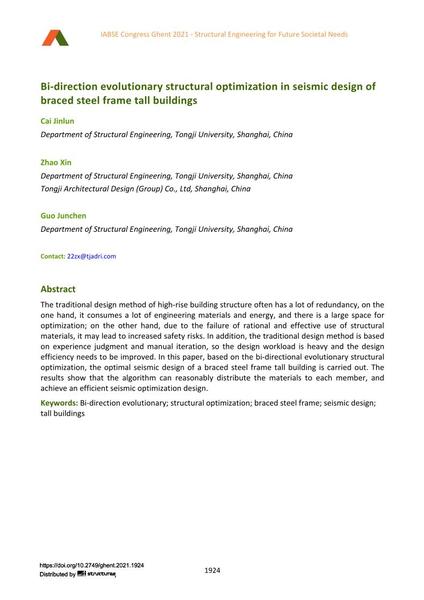Bi-direction evolutionary structural optimization in seismic design of braced steel frame tall buildings

|
|
|||||||||||
Détails bibliographiques
| Auteur(s): |
Cai Jinlun
(Department of Structural Engineering, Tongji University, Shanghai, China)
Zhao Xin (Department of Structural Engineering, Tongji University, Shanghai, China Tongji Architectural Design (Group) Co., Ltd, Shanghai, China) Guo Junchen (Department of Structural Engineering, Tongji University, Shanghai, China) |
||||
|---|---|---|---|---|---|
| Médium: | papier de conférence | ||||
| Langue(s): | anglais | ||||
| Conférence: | IABSE Congress: Structural Engineering for Future Societal Needs, Ghent, Belgium, 22-24 September 2021 | ||||
| Publié dans: | IABSE Congress Ghent 2021 | ||||
|
|||||
| Page(s): | 1924-1930 | ||||
| Nombre total de pages (du PDF): | 7 | ||||
| DOI: | 10.2749/ghent.2021.1924 | ||||
| Abstrait: |
The traditional design method of high-rise building structure often has a lot of redundancy, on the one hand, it consumes a lot of engineering materials and energy, and there is a large space for optimization; on the other hand, due to the failure of rational and effective use of structural materials, it may lead to increased safety risks. In addition, the traditional design method is based on experience judgment and manual iteration, so the design workload is heavy and the design efficiency needs to be improved. In this paper, based on the bi-directional evolutionary structural optimization, the optimal seismic design of a braced steel frame tall building is carried out. The results show that the algorithm can reasonably distribute the materials to each member, and achieve an efficient seismic optimization design. |
||||
| Mots-clé: |
conception sismique
|
||||
| Copyright: | © 2021 International Association for Bridge and Structural Engineering (IABSE) | ||||
| License: | Cette oeuvre ne peut être utilisée sans la permission de l'auteur ou détenteur des droits. |
||||
